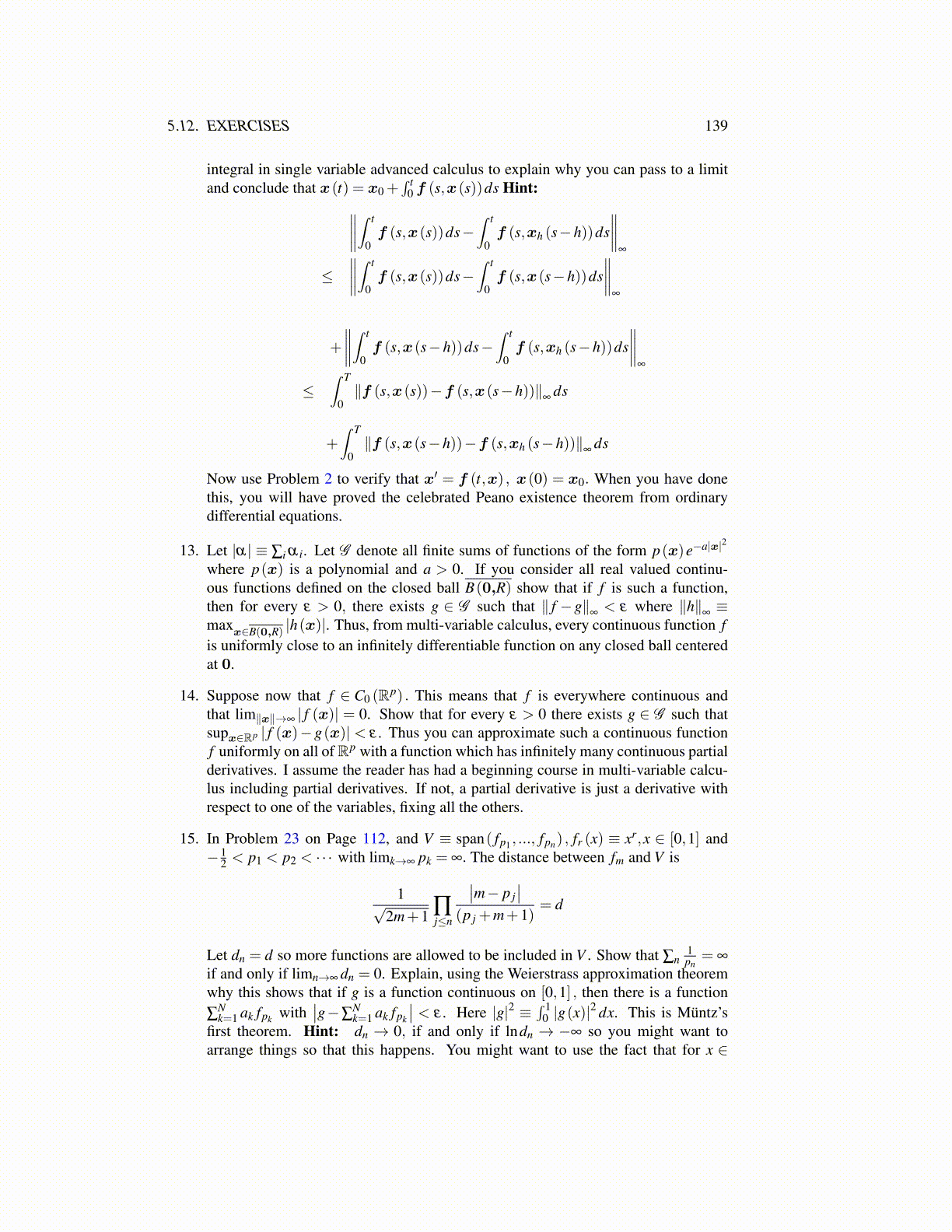
5.12. EXERCISES 139
integral in single variable advanced calculus to explain why you can pass to a limitand conclude that x(t) = x0 +
∫ t0 f (s,x(s))ds Hint:∥∥∥∥∫ t
0f (s,x(s))ds−
∫ t
0f (s,xh (s−h))ds
∥∥∥∥∞
≤∥∥∥∥∫ t
0f (s,x(s))ds−
∫ t
0f (s,x(s−h))ds
∥∥∥∥∞
+
∥∥∥∥∫ t
0f (s,x(s−h))ds−
∫ t
0f (s,xh (s−h))ds
∥∥∥∥∞
≤∫ T
0∥f (s,x(s))−f (s,x(s−h))∥
∞ds
+∫ T
0∥f (s,x(s−h))−f (s,xh (s−h))∥
∞ds
Now use Problem 2 to verify that x′ = f (t,x) , x(0) = x0. When you have donethis, you will have proved the celebrated Peano existence theorem from ordinarydifferential equations.
13. Let |α| ≡ ∑i α i. Let G denote all finite sums of functions of the form p(x)e−a|x|2
where p(x) is a polynomial and a > 0. If you consider all real valued continu-ous functions defined on the closed ball B(0,R) show that if f is such a function,then for every ε > 0, there exists g ∈ G such that ∥ f −g∥
∞< ε where ∥h∥
∞≡
maxx∈B(0,R) |h(x)|. Thus, from multi-variable calculus, every continuous function f
is uniformly close to an infinitely differentiable function on any closed ball centeredat 0.
14. Suppose now that f ∈ C0 (Rp) . This means that f is everywhere continuous andthat lim∥x∥→∞ | f (x)| = 0. Show that for every ε > 0 there exists g ∈ G such thatsupx∈Rp | f (x)−g(x)| < ε . Thus you can approximate such a continuous functionf uniformly on all ofRp with a function which has infinitely many continuous partialderivatives. I assume the reader has had a beginning course in multi-variable calcu-lus including partial derivatives. If not, a partial derivative is just a derivative withrespect to one of the variables, fixing all the others.
15. In Problem 23 on Page 112, and V ≡ span( fp1 , ..., fpn) , fr (x) ≡ xr,x ∈ [0,1] and− 1
2 < p1 < p2 < · · · with limk→∞ pk = ∞. The distance between fm and V is
1√2m+1 ∏
j≤n
∣∣m− p j∣∣
(p j +m+1)= d
Let dn = d so more functions are allowed to be included in V . Show that ∑n1pn
= ∞
if and only if limn→∞ dn = 0. Explain, using the Weierstrass approximation theoremwhy this shows that if g is a function continuous on [0,1] , then there is a function∑
Nk=1 ak fpk with
∣∣g−∑Nk=1 ak fpk
∣∣ < ε . Here |g|2 ≡∫ 1
0 |g(x)|2 dx. This is Müntz’s
first theorem. Hint: dn → 0, if and only if lndn → −∞ so you might want toarrange things so that this happens. You might want to use the fact that for x ∈